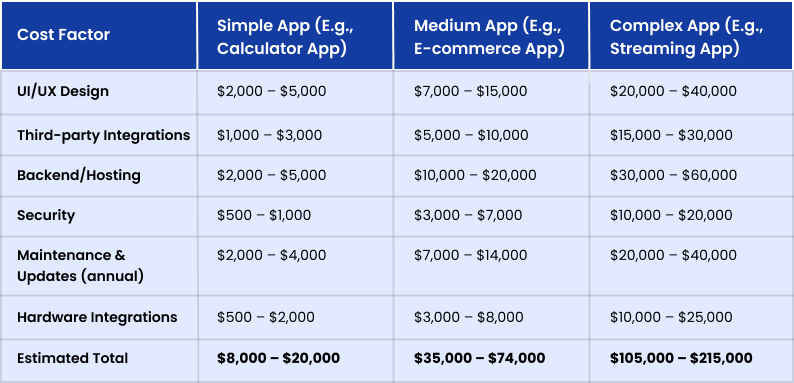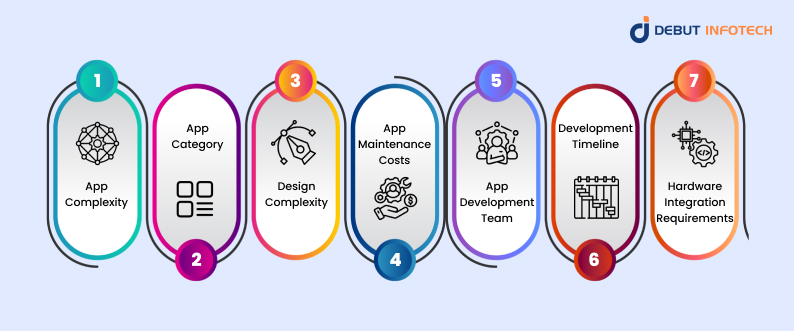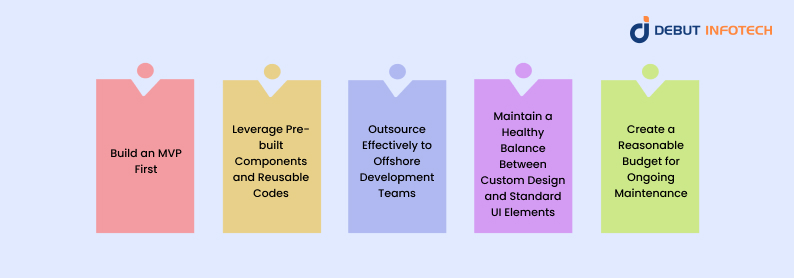Table of Contents
Home / Blog / Mobile Development
A CTO’s Guide to Estimating React Native App Development Cost
April 22, 2025

April 22, 2025
How would you like to have an idea of how much React Native app development costs before venturing into development?
Here at Debut Infotech Pvt Ltd, we can give you an estimated average of different categories of React Native mobile development costs based on our past projects.
We’ll also do you one better by describing how different factors influence your overall React Native App Development price and how to optimize and manage these development costs optimally.
Grab your calculators!
Estimated Breakdown of React Native App Development Cost
The table below gives a estimated breakdown of the app development costs for Simple, Medium, and Complex React Native apps, depending on several factors.

NB: These figures are mere estimated averages of different React Native app projects. They are only meant to give you estimated ideas of what to expect, and are not exact figures set in stone.
Curious About Your App’s Exact Cost?
Leverage Debut Infotech’s years of experience to project how much your app would cost
Factors Influencing the Development Cost of a React Native App

The cost of developing a React Native app varies from app to app depending on a number of factors. The following are some of the most significant factors to look out for:
1. App Complexity
Your React Native app’s complexity refers to its overall scope, sophistication, and technical demands. It includes the complexity of the tasks it is expected to perform, the intricacy of user interactions, the amount of backend processing involved, and more.
However, you can’t exactly classify apps into strict categories based on complexity levels because the differences in features, integrations, and overall complexity between different apps can vary based on app domains, contexts, and user needs.
Nonetheless, we’re going to broadly classify apps into three major domains to give you a base idea for working with them. These major categories include:
- Simple Apps
- Moderate Apps
- Complex Apps
As you might imagine, simple apps most likely cost less than moderate apps, which, in turn, cost less than complex apps.
However, when it comes to app complexity, some specific parameters determine how complex an app is. These are:
- Backend deployment architecture model: These are the ‘behind-the-scenes’ factors controlling how your app functions. Your React Native app’s backend deployment architecture model handles functions like storing data, running business logic, and hosting.
You may choose between a Custom Deployment Architecture or a BaaS architecture.
The custom deployment architecture involves building your entire backend architecture from scratch. In contrast, the BaaS architecture depends on a service that provides a ready-made backend architecture for a fee.
Either of these choices influences the React Native App Development Price.
- Integration with device built-in features: Your app’s complexity also depends on its ability to utilize other built-in features on the user’s device, such as the camera, GPS, fingerprint scanner, or notification services. Each of these built-in device features functions slightly differently on various devices, such as Windows, Mac, iPhone, and Android. Therefore, developers may have to make separate provisions for each device.
- Integration with legacy systems: Legacy or enterprise systems are older or custom databases or software applications, particular to specific organizations or devices. Some apps may need to depend on these legacy systems to function perfectly, and this may use outdated technology or lack good communication systems. Therefore, making such accommodations for them may significantly impact the app’s complexity and, in turn, its cost.
- Admin panel: The admin panel is a special dashboard or interface where app administrators or managers can control the app’s activities and respond to user requests. Some of the administrator’s duties include content updates, user data monitoring, and support request monitoring. An app that requires an admin panel would need extra design, development, and security considerations compared to one that doesn’t.
- Third-party integrations: These are external services or tools with which users may want to combine the app’s functionalities for special purposes. Some examples include payment gateways, social media logins, and analytics platforms.
These factors and more determine whether your React native app is a simple, moderate, or complex application, thus impacting its potential costs.
2. App Category
Another factor that impacts React Native app development cost is the app’s purpose.
Is it a social media app, an e-commerce app, a personal finance tracking tool, a productivity app, or something else?
The logic behind this is that the more complex an app’s function or industry, the more costly it is likely to be. This is because the complexity of the elements present in an app varies from industry to industry.
For instance, a standalone calculator app may not require as many security considerations and features as an e-commerce app that constantly integrates with payment gateways and stores customer essential information.
The same reasoning applies to all the other features that make the app “sophisticated.” These include UI/UX design, third-party integrations, regulatory requirements, backend architecture, etc.
3. Design Complexity
An app’s UI/UX design determines how glued users stay to the app and how easy it is for them to navigate the entire app as they execute their desired activities. Getting this right incurs some costs that contribute significantly to the overall mobile React Native mobile development cost.
On the one hand, top UI/UX designers capable of creating these kinds of intuitive designs charge a high price for their skills and experience. On the other hand, these designs require some essential design elements that require certain infrastructure for implementation.
For context, digital designers charge an average of $44.59 per hour in the US.
As such, a React Native app with simple, standard screens is much cheaper to make than one with lots of custom designs, animations, and interactive features. The more unique, intuitive, and interactive you want your app to feel, the more time it will take to design and build it.
4. App Maintenance Costs
Technically, you’re never really going to stop incurring React Native App Development Costs even after launching. This is because you have to keep up with some technical demands, either stemming from user requests, operating system demands, or general organization upgrades. Some of these app maintenance activities include:
- Fixing bugs and glitches
- Design updates
- Feature improvements and updates
- Security updates
The app maintenance costs for most React Native apps are usually estimated at about 20% of the total development cost. As soon as you launch your app, it is essential to budget for this to prevent it from being outdated, buggy, or unusable.
5. App Development Team
The hiring and management costs of the app development team directly impact the React Native Development Costs because the team’s expertise and experience directly affect the app’s quality.
For starters, experienced React Native app developers typically charge more for their services than mid-level or entry-level professionals. Their deep understanding of established methodologies puts them a step ahead of others, making it easy for them to structure and deliver projects more efficiently.
Regardless of experience and expertise levels, most businesses opt for either of the following options when selecting the professionals who’ll build their apps. These are:
- Freelancers
- In-house development teams
- Top mobile app development companies
Amidst these options, freelancers appear to be one of the cheapest options because you could just hire someone quickly on platforms like Upwork. However, these cost trade-offs may have significant implications in terms of quality and app scalability. On the other hand, in-house teams may seem like the perfect option to build a custom solution. However, the React Native application development costs associated with in-house development teams may be too steep.
A top React Native App development company like Debut Infotech Pvt Ltd, on the other hand, is the sweet spot for any business seeking the most cost-effective option. Top mobile development companies like this offer budget-friendly pricing that freelancers offer, in addition to the team foresight and scalability that in-house teams offer.
6. Development Timeline
How soon do you need the app delivered?
The development timeline somehow affects the overall cost of React Native app development. However, there is more of a nuanced correlation between time and cost.
For example, an app development team that charges by the hour might charge more if the app takes longer to complete and deploy. Extended development timelines mean more billable hours for developers, designers, and project managers, not to mention the sustained resource allocations and infrastructure costs that increase the overall labour costs.
On the other hand, some top mobile app development companies charge a standard fee for delivering a standard React Native app based on your requirements and set a delivery time. However, should you need the app earlier, they may have to add more developers, designers, and project managers, thus increasing the price.
7. Hardware Integration Requirements
Most simple mobile apps are often structured to function as standalone applications — that’s simple.
However, when the requirements involve the app connecting with hardware components, things start to get a bit complicated. This is because they add layers of complexity to the app, require specialized skills, and require more time for development and testing.
For instance, hardware components like GPS, sensors, biometric devices, and cameras require developers to write extra code to ensure seamless communication with the hardware feature.
Not only that.
They also require specialized testing and debugging operations to ensure things are working smoothly. There’s also the ‘not so little’ cost implications of IoT integrations.
Most importantly, only a select number of developers are properly skilled and experienced in hardware integrations.
How to Optimize and Control React Native App Development Cost — A Smart Executive’s Development Strategy

Do you feel like all the features discussed above hint at a huge budget?
Relax!
Having been building React Native apps for some time now, our experts at Debut Infotech Pvt Ltd have become quite skilled at crafting a cost-effective development strategy that doesn’t sacrifice quality.
We’ll be sharing some of those nuggets with you in this section.
If you’re a smart executive looking to optimize and minimize your React Native Development Cost, the following tips are for you:
1. Build an MVP First
An MVP is a Minimum Viable Product, an initial ‘pruned down’ version of your app idea containing only the most essential features, highlighting your React Native app’s unique value proposition. As you might have imagined, a full-fledged app might require significant costs, and you don’t have an immediate guarantee that the first version of what you’re building is what your target audience needs.
So, instead of diving in head first, an MVP helps you test the waters by providing immediate value to the audience at a fraction of the development costs. At the same time, you get to gather enough data and feedback that can be used to improve your future app iterations.
A win-win situation for you and the target audience!
2. Leverage Pre-built Components and Reusable Codes
One of the main advantages of building an app using React Native is the availability of open-source libraries and reusable components. For instance, UI kits like the React Native Paper and Nativebase already possess pre-designed design elements that could help you reduce the costs associated with custom design. Therefore, it is advisable to leverage these pre-built components and reusable codes for specific segments of your app that don’t require as many customisations.
3. Outsource Effectively to Offshore Development Teams
When trying to optimize and manage your React Native app development cost, your goal should be to obtain the maximum quality possible while minimizing cost. There have been multiple reports that most offshore development teams in regions like India and Eastern Europe often have an abundance of skilled developers who charge significantly less compared to other regions due to the average costs of living in these areas.
For instance, Debut Infotech Pvt Ltd has distributed teams across these areas who are competent enough to deliver top results at competitive prices without sacrificing quality.
4. Maintain a Healthy Balance Between Custom Design and Standard UI Elements
Although we hinted at this earlier, it is worth revisiting because design costs are one of the major factors influencing the overall cost of React Native application development.
Some brand-defining parts of your app require custom UI/UX designs while others can function perfectly with standard or pre-built design components. Identifying these different parts and maintaining a coherent balance between them can help you avoid some costs.
5. Create a Reasonable Budget for Ongoing Maintenance
Ongoing maintenance costs are almost unavoidable if you want your app to keep up with rising user demands and system updates after you launch. Therefore, it is advisable to set aside an untouchable budget for it as soon as your app launches to avoid any surprises.
Kick-start Your React Native App Development With a Custom Quote
At Debut Infotech, we provide transparent, tailored assessments for your React Native app vision, covering everything from ideation to deployment.
Conclusion
React Native app development costs about between USD 8,000 and USD 20,000 for simple apps, USD 35,000 and USD 74,000 for medium apps, and about USD 105,000 – 215,000 for complex apps.
These estimated prices vary from app to app depending on factors like the backend complexities, hosting requirements, security features, maintenance updates, and hardware integrations. However, the figures are not set in stone.
If you would like a more accurate estimate figure for the specific React Native app idea you’re about to implement, contact our mobile app development experts at Debut Infotech Pvt Ltd for a quote today!
Frequently Asked Questions (FAQs)
React Native developer hiring prices vary by region and level of experience. Hourly wages in the United States usually fall between $50 and $75, with an average of roughly $62 per hour. Rates can be as low as $20 to $40 per hour abroad.
The complexity, design, backend requirements, and developer location all affect the cost of deploying a React Native application. Simple apps typically cost between $10,000 and $30,000 to launch, midrange apps cost between $30,000 and $70,000, and large apps cost between $70,000 and $150,000+.
React Native is open source and totally free. It has no license costs and may be used to create iOS and Android mobile apps. However, you might have to pay for premium libraries, third-party services, or extra tools as needed.
Freelance React Native developers earn between $20 and $60 per hour, depending on their region and level of experience. For instance, while senior or specialist freelancers can command prices as high as $80 to $120 per hour in some places, junior developers charge at the lower end of the spectrum.
Yes, React Native is sufficient to create a top-notch iOS and Android mobile application. Major brands worldwide use it because it provides cross-platform development, native-like performance, and access to device features.
Talk With Our Expert
Our Latest Insights
USA
2102 Linden LN, Palatine, IL 60067
+1-703-537-5009
[email protected]
UK
Debut Infotech Pvt Ltd
7 Pound Close, Yarnton, Oxfordshire, OX51QG
+44-770-304-0079
[email protected]
Canada
Debut Infotech Pvt Ltd
326 Parkvale Drive, Kitchener, ON N2R1Y7
+1-703-537-5009
[email protected]
INDIA
Debut Infotech Pvt Ltd
C-204, Ground floor, Industrial Area Phase 8B, Mohali, PB 160055
9888402396
[email protected]




Leave a Comment